
Study: 43% of SEA buyers make first-ever online purchase via mega sales day
share on
From Singles' Day and Black Friday to Cyber Monday and the double-digit shopping festivals in Southeast Asia, mega sales days have become common place for consumers and brands. While the use of eCommerce might have skyrocketed during the pandemic, a recent report by Facebook and Bain & Company titled "SYNC Southeast Asia: Discover the new wave of mega sale shoppers" found that for 43% of the shoppers in the region, their first mega sales day was also their first-time shopping online.
The report used data from GlobalWebIndex Core Survey Panel involving 3,919 internet users aged 16 to 64 during the fourth quarter of 2020 across six Southeast Asian countries: Singapore, Malaysia, Indonesia, the Philippines, Thailand, and Vietnam. In particular, Thailand (64%) and Vietnam (53%) had the highest percentage of first-time online shoppers. Meanwhile, only 30% of people in Singapore used a mega sales day to shop online for the first time, followed by 37% in Indonesia and 38% in Malaysia.
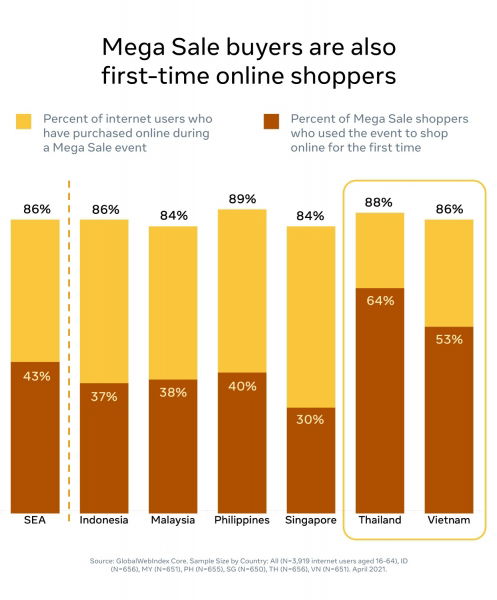
Social media is also crucial to driving discovery commerce, with 63% of those surveyed reporting they mainly rely on this medium to discover new products. Among first-time buyers, the number who shared the same sentiment was 66%. Social media is the popular tool for product discovery among first-time shoppers in the Philippines (77%), followed by Vietnam (72%), and Thailand (68%). Additionally, video is also fast becoming a key source of inspiration for the discovery of new products. Among those who discovered products on social media, the majority of them (62%) said they ended up buying a product via in-stream video ads followed by short-form video ads such as Stories (51%).
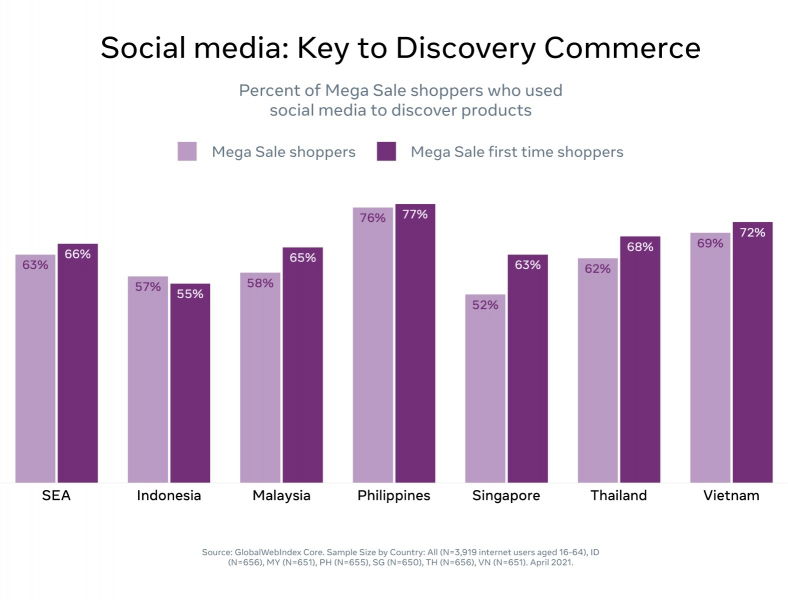
Despite the influx of mega sales days, consumers are always prepared for it. The study found that 72% of consumers in Southeast Asia plan ahead of the sales event. In general, they are more likely to prepare for high-ticket purchases, mainly with smartphones (56%), home living (52%), and electronic devices (51%). To a lesser extent, this also includes home appliances (47%), sports, health and wellness (43%), and fashion and accessories (42% for men and 40% for women).
There are also categories that consumers buy on impulse, mainly F&B (47%) and women’s and men’s fashion (39% and 37%, respectively). According to the report, tinfluence on consumers can differ from country to country. For example, in Vietnam home living and household groceries is the most popular category people prepare for. In the Philippines, the most popular category for impulse purchases is beauty, skincare and personal care.
Purchasing from categories they haven't tried before
Consumers are also using mega sales days to buy from they have not tried before, with the most common one being smartphones and accessories (46%), followed by men's fashion (40%) and women's fashion (40%). Rounding off the top five were beauty and personal care (39%) and electronic devices and accessories (38%).
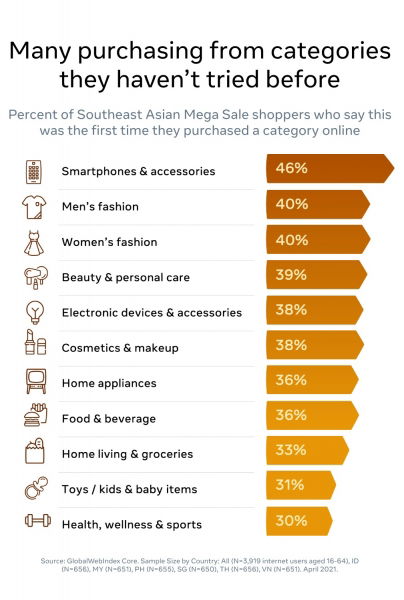
At the same time, most shoppers are likely to try new brands with 91% in Southeast Asia indicating they have purchased a brand they never tried before. This was a popular consumer habit in Vietnam (95%) and Thailand (93%) followed by Indonesia (90%) and Malaysia (90%). Interestingly, consumers are also willing to re-purchase the new brands they discovered during mega sales day. This sentiment was most evident in Vietnam (83%), the Philippines (77%), Thailand and Malaysia (75% each).
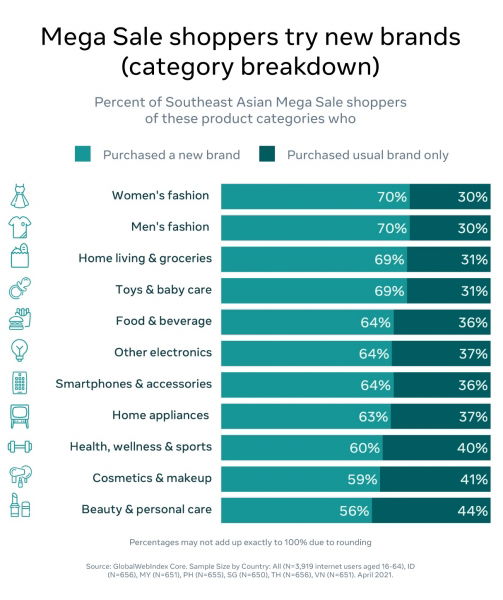
While the openness to trying new brands is seen across all categories, it is much more pronounced in men's and women's fashion (70% each), home living and household groceries (69%), and toys and baby items (69%). At the same time, buyers were also found to remain loyal to brands for categories that rely more on personal preference, such as beauty, skincare, and personal care. According to the report, 44% plan to stick to their usual brand. Meanwhile, customers who indicated an interest in re-purchasing the new brands plan to do so for categories such as electronics, smartphone and accessories, and men's fashion (61% each), F&B (59%), and home appliances (58%).
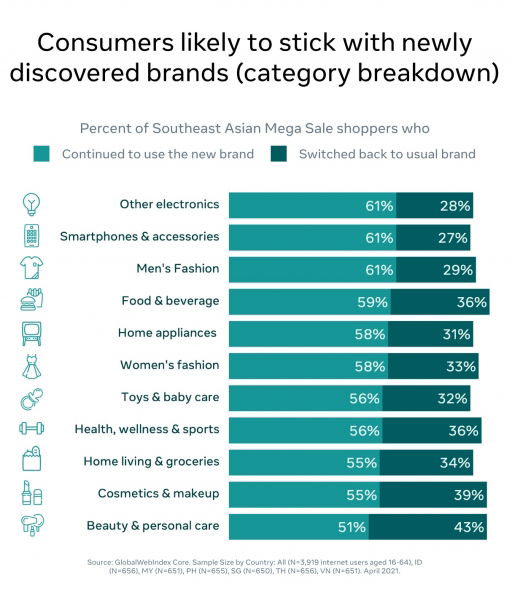
Benjamin Joe, VP of Southeast Asia and emerging markets at Facebook, said mega sales days have evolved beyond being just a discount-driven activity. "They are now a collective cultural moment and present opportunities for businesses to build their brand and ensure that their product or service finds the people who are most likely to love it," he said.
Meanwhile, despite the current restricted business environment, Bain & Company's partner Praneeth Yendamuri said Southeast Asia’s digital economy is still on track to cross US$300 billion by 2025 with over 40 million people coming online for the first time in 2020. "At present, only 70% of the region is online and we foresee events like Mega-Sales Days playing a significant role in further helping the region unlock the full potential of its digital economy," Yendamuri said.
Photo courtesy: 123RF
Related articles:
Analysis: Will consumer trust erode if eCommerce platforms cannot rid counterfeits?
Visa study: More Filipino first time eCommerce users due to pandemic
Analysis: Why RedMart SG's data breach is unlikely to dampen Lazada's mega 11.11 bash
Tmall rolls out livestreaming across bonded warehouses at 11.11 shopping festival
Amazon gears up for Prime Day in SG, says owned and paid channels key in marketing mix
share on
Free newsletter
Get the daily lowdown on Asia's top marketing stories.
We break down the big and messy topics of the day so you're updated on the most important developments in Asia's marketing development – for free.
subscribe now open in new window
